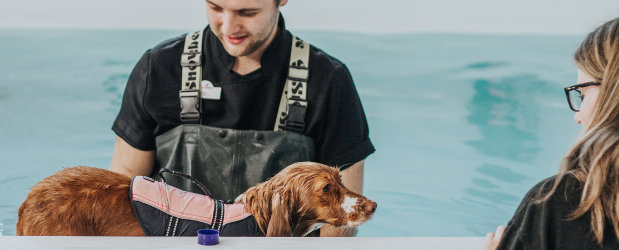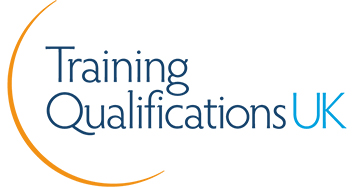
There are many reasons small animals can find themselves needing human assisted therapy. They may have acquired an injury, gained weight, have a chronic condition or are simply feeling the effects of old age. Whatever their ailment, hydrotherapy is quickly becoming a preferential form of treatment. Making it an ideal time to train to become an animal hydrotherapist.
The challenges animals can face can negatively impact their emotional state, motivation and quality of life if left untreated. And since many people deeply care for their companion animals, they seek professional help to prolong healthy lives for them.
It isn’t always possible to effectively treat painful conditions with medication. As such, a need was identified for a multi-model approach. Water-based therapy was since introduced to the animal care remit as it can reduce pain and enable movement and function to return.
Now, small animal hydrotherapy is used to treat anything from neurological and orthopaedic issues to rehabilitation post-surgery and degenerative locomotive disorders. With increasing numbers of veterinary practices and referral centres adding the low-impact treatment to their provision.
However, trained staff are required to deliver this treatment. Which means you need to get qualified to become an animal hydrotherapist. Luckily, this doesn’t require a degree and you can qualify within months.

What the role involves
Unlike most therapeutic careers, working as a small animal hydrotherapist is a role that requires strength and stamina. Helping animals perform specific exercises can be a challenge, especially if they’re not a fan of water. So, getting hands-on and physically encouraging them to do the exercises is a big part of the role.
Besides needing to be able to swim and move well through water, you must be confident handling animals. It can be a challenge, but once you get the hang of it, both you and your animal patients can enjoy the experience. Plus, you’ll feel a great sense of fulfilment as you see them improve because of your sessions.
There are three methods of hydrotherapy you can use:
Pool
Encouraging animal patients to perform swimming exercises to improve flexion in joints, musculature, use of arthritic and dysplastic joints and cardiovascular fitness.
Underwater Treadmill
Harnessing the underlying principles of water and speed to sustain health, mobility, weight, and rehabilitation. Which can help with intervertebral disc disease, post-surgical conditions, sporting injuries, neurological and joint conditions.
Spa
Using non-exercise based standing or lay down treatments in warm water. This is often used for physiotherapy, stretching and range-of-motion exercises, pre-exercise warm up or post-therapeutic cool down.
With these treatments and your help, animals can improve overall function, lose weight and alleviate their pain. Prolonging a more comfortable and healthier life.
You can progress into senior roles with experience, such as an area team supervisor, training manager or regional training manager. There is also the option to become self-employed and set up your own facility. This would enable you to dictate your own hours, rate of pay and fit your work more easily around your lifestyle.

The skills you’ll need
Working as a small animal hydrotherapist before anything requires you to be fond of animals and comfortable working around them.
As it requires lots of physical contact, employers prefer candidates with some form of animal handling experience. You’ll also need to be able to read the animal’s mood and emotions. As you need to know when they aren’t comfortable and where to draw the line with their abilities. Communication skills are also essential for informing animal carers about treatments processes and progress. As is having an interest in science and animal health.
Outside of these desirable traits, there aren’t any set entry requirements to become an animal hydrotherapist. Employers will set their own but as is usually the case, you’ll have a better chance of securing a position with relevant experience and qualifications.
Most companies provide on-the-job training. So, a person trained in human hydrotherapy, for instance, can be taught how to effectively work with animals. And other animal related professionals can receive the necessary hydrotherapy training. Altogether, the training typically encompasses anatomy and physiology, canine & feline first-aid, hydrotherapy theory and pool water management.
But entry requirements are changing. Now that the animal hydrotherapy field is a professionally recognised area of complementary therapy, the standards of education are increasing.

How to get qualified
Despite being recognised, animal hydrotherapy is still an unregulated profession. But industry associations now exist to help training providers maintain professionalism and clinical standards.
If you want to become a registered Canine Hydrotherapist in the UK, then you should look out for qualifications that enable you to become a member of the Canine Hydrotherapy Association (CHA) the National Association of Registered Canine Hydrotherapists (NARCH) or the Institute of Canine Hydrotherapists (ICH).
You can take these courses that are also registered on the Regulated Qualifications Framework (RQF):
Small Animal Hydrotherapy Level 3 Certificate
This covers the core approaches to and principles of small animal hydrotherapy. It teaches you what hydrotherapy is and how it can improve certain conditions in small animals. You’ll learn about common orthopaedic and neurological conditions, the surgeries that correct them and how to provide effective hydrotherapy treatment.
Small Animal Hydrotherapy Level 3 Diploma
The diploma explores the key practises of hydrotherapy and how you should provide them. As well as going deeper into animal behaviour, anatomy and biology, hydrotherapy best practise, legislation and treatment.
Small Animal Hydrotherapy Level 4 Diploma
This follows on from the Level 3 diploma and covers a wider range of topics. You’ll learn about advanced pool and aquatic treadmill techniques, how to treat, care for and handle animals correctly and safely. You will also explore methods to develop treatment programmes for your patients, monitor their progress and assess their results.

There are also courses for those trained in small animal hydrotherapy who want to focus on targeted areas of treatment. Such as those dedicated to aquatic treadmill therapy, which are also registered on the Regulated Qualifications Framework (RQF):
Aquatic Treadmill Therapy for Small Animals Level 3 Award
An introduction to aquatic treadmill therapy for learners already holding the Level 3 Certificate in Hydrotherapy for Small Animals. Teaching you how to identify animals suitable for this form of treatment and how to safely operate the aquatic treadmill.
Advanced Aquatic Treadmill Therapy for Small Animals Level 3 Award
Aimed at those already qualified to work with small animals, who also possess the lower-level aquatic treadmill therapy award. Building on your existing knowledge, so you can provide the next level of support. From conducting gait analysis to identifying abnormal posture and understanding how to review patient performance. You’ll also understand how to use advanced aquatic treadmill techniques during therapy.
Start your Learning
These online courses will give you the essential knowledge to become an animal hydrotherapist. While the majority of the work is completed online, they also incorporate practical training within a rehabilitation centre.
This provides you the opportunity to work alongside experienced and qualified hydrotherapists and physiotherapists. So you can put your learning into practice and gain the hands-on experience employers want.
The online element can be completed at home, at a time that suits you. Allowing you to organise your education around your lifestyle and keep to your existing work or family commitments.
Stonebridge Associated Colleges is the leading UK distance learning provider, with a faculty dedicated to animal health and welfare.
Click below to find out more about how to start your new career as a small animal hydrotherapist.






Leave a Reply